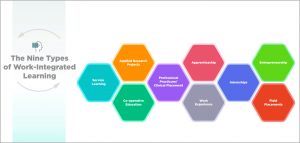Types of Workplace-integrated Learning
Beyond the Classroom
It can be argued extensively that a substantial part of learning takes place beyond the formal classroom contexts (Coates, 2009). The Australasian Survey of Student Engagement (AUSSE) reinforces the value of this critical aspect of supporting learner needs with findings reported that students value the support extended by peers, support by teaching staff and seeking career-related advice in their journey of becoming work-ready graduates (Coates, 2009).
Kaider et al. (2017) proposed an authenticity-proximity framework with examples of activities that encompass introductory, year 2/3 and placement levels of university education.
WIL may present itself as various different types of experiences, and our focus is more aligned with work connections as part of the online classroom. Even though Co-op work terms and field placements are considered as WIL examples, these popular types are not explored within this module.
A few innovative WIL models are getting a lot of attention. Micro-placements, online projects, competitions (hackathons), incubators/ start-ups and consulting are part of the WIL portfolio. Which of these WIL types does your organization put the most emphasis on?

It has been observed that when students feel that they are being guided properly, their motivation for learning from WIL is enhanced. The students should be supported with an in-depth explanation about the relevance of WIL, structured instruction, and assessment framework. This module will take you a little deep into WIL to better understand your role in implementing ways to enhance student engagement in WIL, with special emphasis on high-value integrated learning.
Learning Objectives
By the end of this module, you will be able to:
- Discuss concepts and methods for using workplace-integrated learning within your course;
- Examine methods to assist learners in their development of goal-oriented behaviour habits;
- Describe methods to help sustain engagement and enrich the educational experience.

